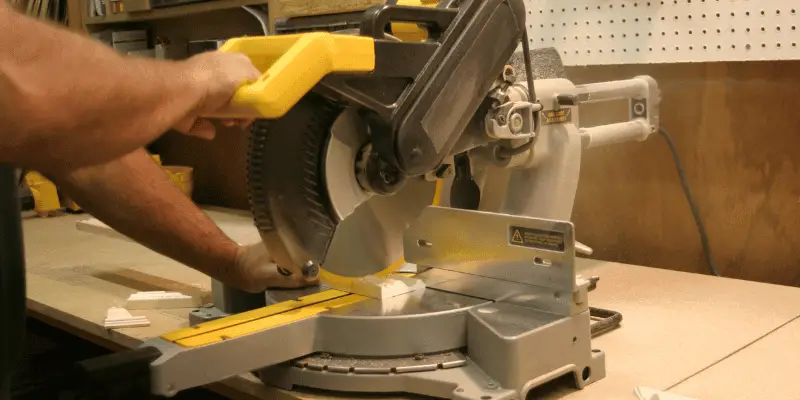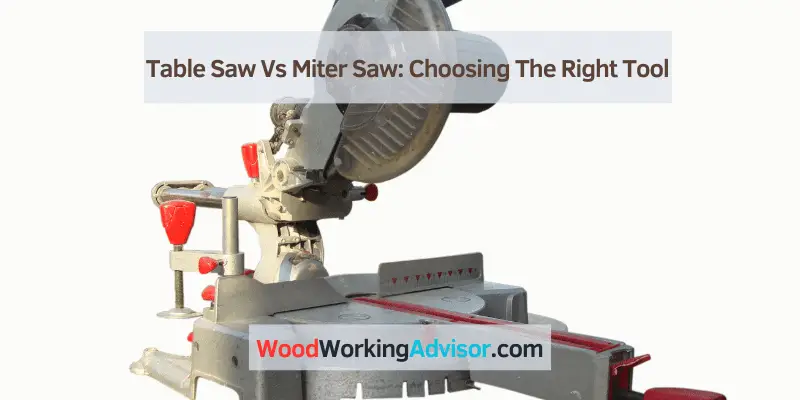When choosing between a table saw and a miter saw, consider the type of cuts you need. A table saw is ideal for making long rip cuts while a miter saw is better for crosscuts and angled cuts.
It’s important to understand the strengths and limitations of each tool to make an informed decision. Table saws and miter saws are both essential tools for woodworking and construction projects. While they may appear similar at first glance, these power tools have distinct features and functionalities that cater to different cutting needs.
Understanding the differences between table saws and miter saws is crucial for selecting the right tool for your specific projects. This guide will provide a comprehensive comparison of table saws and miter saws, outlining their unique capabilities and helping you make an informed decision based on your cutting requirements.
Table Saw Vs Miter Saw: An Overview
When it comes to woodworking, utilizing the right tools is crucial for achieving precision and efficiency. Two of the most essential power tools for any woodworker are the table saw and the miter saw. In this overview, we’ll delve into the fundamental differences between these two power tools to help you understand their distinct features and applications.
Understanding The Fundamental Differences
Both the table saw and miter saw are valuable assets in a woodworker’s arsenal, each with its own unique attributes and functionalities. To comprehend their disparities, it’s essential to analyze their primary uses, cutting capabilities, and design.
- Primary Uses: While a table saw is ideal for making long, straight cuts and ripping large sheets of wood, a miter saw excels at creating precise crosscuts, miter cuts, and bevel cuts.
- Cutting Capabilities: Table saws are typically utilized for rip cuts, where the wood is pushed through the saw blade. In contrast, miter saws are perfect for accurately chopping wood at various angles.
- Design: Table saws feature a flat surface with a blade protruding from the center, enabling users to guide material through the blade. On the other hand, miter saws have a stationary flat table with a rotating arm that lowers the blade onto the wood for cutting.
Ensuring Accuracy And Precision
When it comes to woodworking, Marah, ensuring accuracy and precision is crucial for achieving professional results. Each day, output material is used in the same direction with reliable cutting results and consistent output material origin. In addition, vertical cuts can be made until the material the table can be easily tilted to various cutting angles.
Functionality And Versatility
When it comes to woodworking, having the right tools can make all the difference in the efficiency and precision of your work. Two popular saws used in woodworking are the table saw and miter saw, each with its own unique functionality and versatility. Understanding the applications and limitations of both tools can help you determine which one is best suited for your specific woodworking needs.
Applications And Limitations Of Table Saw
A table saw is a versatile and powerful tool that is commonly used for making long, straight cuts in lumber. Its large surface area and adjustable blade make it suitable for ripping, cross-cutting, and beveling various types of wood. Its limitations lie in its ability to make precise angled cuts, and it may not be the best choice for intricate trim work or molding.
Applications And Limitations Of Miter Saw
On the other hand, a miter saw is specifically designed for making angled cuts, making it ideal for trim work, crown molding, and picture frames. Its limitation lies in its restricted cutting capacity for long pieces of lumber, as well as its less versatile nature compared to a table saw. However, for making accurate and repeatable angled cuts, a miter saw is unmatched.

Precision And Accuracy
The precision and accuracy of woodworking tools are essential for achieving high-quality results in any project. When it comes to table saws versus miter saws, understanding their cutting capabilities and unique features is critical in determining which tool is best suited to meet your precision needs.
Comparing Cutting Capabilities
Both table saws and miter saws are capable of delivering precise cuts; however, their cutting capabilities differ based on the type of cuts they excel at. Table saws are ideal for making long, straight cuts in larger workpieces and sheets of material. On the other hand, miter saws are designed for making accurate crosscuts and angled cuts. This distinction in cutting capabilities is essential to consider when aiming for precision in woodworking projects.
Understanding Unique Features For Accuracy
Table saws feature a flat, stable surface that allows for consistent and accurate cuts when using various cutting accessories. They typically have adjustable rip fences and miter gauges, enabling precise adjustments for different types of cuts. On the other hand, miter saws come with preset angles and stops, making it easier to achieve accurate miter and bevel cuts with minimal adjustments.Miter saws also have a rotating table that allows for angled cuts with precision and repeatability.
Safety Considerations
When working with power tools like table saws and miter saws, ensuring safety is of utmost importance. Understanding the potential hazards and safety precautions, as well as comparing safety measures and best practices, can help keep woodworkers safe in their workshops.
Potential Hazards
Before using a table saw or miter saw, it’s essential to be aware of the potential hazards associated with these tools.
- Kickbacks: The powerful spinning blade of a table saw or miter saw can cause wood to be ejected forcefully, posing a significant risk of injury.
- Blade Contact: Accidental contact with the sharp blades of these saws can result in severe cuts and lacerations.
- Dust and Debris: The cutting process generates a substantial amount of sawdust and debris, which can lead to respiratory issues if proper precautions are not taken.
- Electrical Hazards: As with all power tools, the risk of electrical shocks and fires exists if the tools are not used and maintained properly.
Safety Precautions
Implementing safety precautions can significantly reduce the risk of accidents and injuries when using table saws and miter saws.
- Wear Personal Protective Equipment (PPE): Always wear eye protection, hearing protection, and dust masks to safeguard against potential injuries and hazards.
- Use Blade Guards and Splitters: Keep the blade guards and splitters in place to prevent kickbacks and minimize the risk of accidental contact with the blade.
- Maintain a Clean Workspace: Regularly clean the work area to minimize the accumulation of sawdust and debris, reducing the risk of respiratory issues and fire hazards.
- Follow Safety Guidelines: Adhere to the manufacturer’s safety guidelines and recommendations for operating and maintaining the table saw or miter saw.
Comparing Safety Measures And Best Practices
When comparing the safety measures and best practices for table saws and miter saws, it’s essential to understand the specific safety features and operational procedures for each type of saw.
Frequently Asked Questions Of Table Saw Vs Miter Saw
What Are The Key Differences Between A Table Saw And A Miter Saw?
A table saw is primarily used for ripping long boards, while a miter saw is better for cross-cutting. A table saw has a larger work surface and offers more precision, whereas a miter saw provides better control for angled cuts.
Can A Miter Saw Be Used For The Same Tasks As A Table Saw?
While a miter saw can perform some of the same tasks as a table saw, it’s best suited for cross-cutting and angled cuts. Table saws are more versatile, allowing for a wider range of cuts, including ripping and shaping of long boards.
Which Saw Is Safer For A Beginner – Table Saw Or Miter Saw?
Both table saws and miter saws can be used safely by beginners with the proper precautions. However, miter saws are often considered to be safer for beginners due to their controlled cutting motion and stable work surface. Always follow safety guidelines and wear protective gear.
Conclusion
In the end, the choice between a table saw and miter saw depends on your specific needs. Consider the types of cuts you’ll be making and the level of precision required. Both saws offer unique benefits, so it’s important to carefully assess your projects before deciding on the best tool for the job.



3 thoughts on “Table Saw Vs Miter Saw: Choosing The Right Tool”